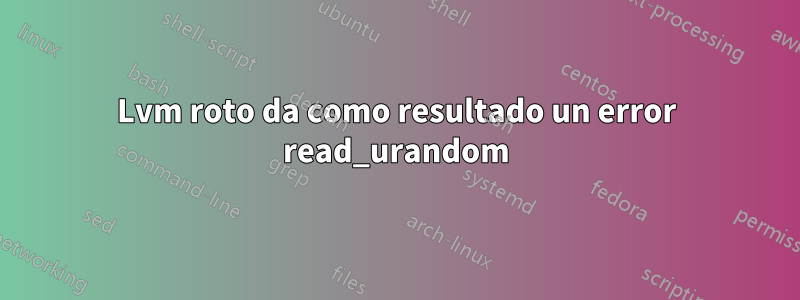
Estaba haciendo algo en un chroot y desafortunadamente rompí el host. Ahora no puedo administrar los grupos de volúmenes:
pvs
read_urandom: /dev/urandom: open failed: No such file or directory
Mismo error con diferentes comandos sobre lvm. Intentando reconfigurar:
# dpkg-reconfigure linux-image-4.19.0-16-amd64
/etc/kernel/postinst.d/dkms:
dkms: running auto installation service for kernel 4.19.0-16-amd64:/usr/sbin/dkms: line 3345: /dev/fd/62: No such file or directory
.
/etc/kernel/postinst.d/initramfs-tools:
update-initramfs: Generating /boot/initrd.img-4.19.0-16-amd64
cryptsetup: ERROR: Couldn't resolve device
/dev/mapper/rootvg-root--server--alpha--host
cryptsetup: WARNING: Couldn't determine root device
cryptsetup: ERROR: Couldn't resolve device /dev/dm-1 (deleted)
cryptsetup: ERROR: Couldn't resolve device
UUID=e9ef352b-a648-4499-ade2-54235f40a3df
W: Couldn't identify type of root file system for fsck hook
I: The initramfs will attempt to resume from /dev/dm-1 (deleted)
I: Set the RESUME variable to override this.
/etc/kernel/postinst.d/zz-update-grub:
/usr/sbin/grub-probe: error: failed to get canonical path of `/dev/mapper/rootvg-root--server--alpha--host'.
run-parts: /etc/kernel/postinst.d/zz-update-grub exited with return code 1
Intentando actualizar initramfs:
# update-initramfs -u
update-initramfs: Generating /boot/initrd.img-4.19.0-16-amd64
cryptsetup: ERROR: Couldn't resolve device
/dev/mapper/rootvg-root--server--alpha--host
cryptsetup: WARNING: Couldn't determine root device
cryptsetup: ERROR: Couldn't resolve device /dev/dm-1 (deleted)
cryptsetup: ERROR: Couldn't resolve device
UUID=e9ef352b-a648-4499-ade2-54235f40a3df
W: Couldn't identify type of root file system for fsck hook
I: The initramfs will attempt to resume from /dev/dm-1 (deleted)
I: Set the RESUME variable to override this.
Arquitectura de partición:
# lsblk
NAME MAJ:MIN RM SIZE RO TYPE MOUNTPOINT
nvme1n1 259:0 0 1.8T 0 disk
├─nvme1n1p1 259:2 0 2M 0 part
│ └─md1 9:1 0 2M 0 raid1
├─nvme1n1p2 259:3 0 510M 0 part
│ └─md2 9:2 0 509M 0 raid1 /boot
└─nvme1n1p3 259:4 0 1.8T 0 part
└─md3 9:3 0 1.8T 0 raid1
└─croot 253:0 0 1.8T 0 crypt
├─rootvg-swap--server--alpha--host 253:1 0 8G 0 lvm
├─rootvg-root--server--alpha--host 253:2 0 1.5T 0 lvm /
├─rootvg-root--vm1 253:3 0 100G 0 lvm
├─rootvg-root--vm2 253:4 0 20G 0 lvm
├─rootvg-root--vm3 253:5 0 40G 0 lvm
└─rootvg-root--vm4 253:6 0 100G 0 lvm
nvme0n1 259:1 0 1.8T 0 disk
├─nvme0n1p1 259:5 0 2M 0 part
│ └─md1 9:1 0 2M 0 raid1
├─nvme0n1p2 259:6 0 510M 0 part
│ └─md2 9:2 0 509M 0 raid1 /boot
└─nvme0n1p3 259:7 0 1.8T 0 part
└─md3 9:3 0 1.8T 0 raid1
└─croot 253:0 0 1.8T 0 crypt
├─rootvg-swap--server--alpha--host 253:1 0 8G 0 lvm
├─rootvg-root--server--alpha--host 253:2 0 1.5T 0 lvm /
├─rootvg-root--vm1 253:3 0 100G 0 lvm
├─rootvg-root--vm2 253:4 0 20G 0 lvm
├─rootvg-root--vm3 253:5 0 40G 0 lvm
└─rootvg-root--vm4 253:6 0 100G 0 lvm
El problema estaba en hacer chroot en rootvg-root--vm4. Quizás debido a update-initramfs o a la eliminación de archivos en /mnt que afectaron los procesos en ejecución en el host. Ahora ni siquiera puedo eliminar ese volumen y tengo miedo de perder el servidor si se reinicia...
esperando su apoyo, gracias de antemano.
editado:
Más acciones: Intentando reiniciar una VM:
$ sudo virsh start vm2-bastion
sudo virsh start vm2
error: Failed to start domain vm2
error: internal error: Failed to probe QEMU binary with QMP: Could not access KVM kernel module: No such file or directory
qemu-system-x86_64: failed to initialize KVM: No such file or directory
qemu-system-x86_64: Back to tcg accelerator
Perdió el acceso convencional vía SSH:
$ ssh user@ip
PTY allocation request failed on channel 0
...pero logré iniciar sesión usando:
$ ssh user@ip "/bin/bash -i"
bash: cannot set terminal process group (-1): Inappropriate ioctl for device
bash: no job control in this shell
user@server-alpha-host:~$
Respuesta1
Ahora ni siquiera puedo eliminar ese volumen y tengo miedo de perder el servidor si se reinicia...
Haga una copia de seguridad de cualquier dato importante. Si este host es importante para usted, debe ser posible reconstruirlo y recuperarlo.
Determine si se montó algún dispositivo de bloque, dónde y cuándo ocurrió la eliminación, y si le interesan los datos que contiene. Posiblemente no, pero sólo porque lo envió SIGINT no significa que la eliminación se detuvo en los nodos del dispositivo.
La falta de /dev/urandom, /dev/kvm, dispositivos de bloque, /proc y otros dispositivos dañarán muchas cosas. Reinicie para recuperarlos. devtmpfs y udev recrean normalmente los nodos de dispositivo en cada arranque. Este reinicio es para garantizar que todos los programas que se comportan mal se reinicien y esto debe ocurrir eventualmente.


